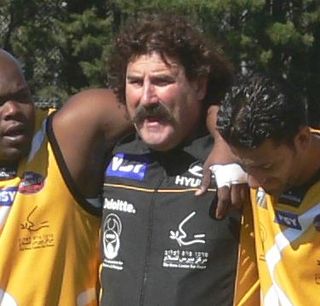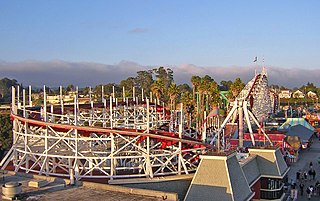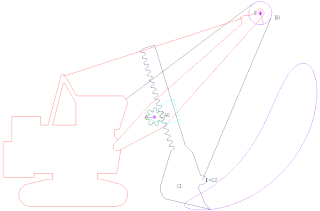The Big/Great Dipper is the American English term for the seven brightest stars of Ursa Major.

Ursa Major is a constellation in the northern sky, whose associated mythology likely dates back into prehistory. Its Latin name means "greater she-bear", standing as a reference to and in direct contrast with nearby Ursa Minor, the lesser bear. In antiquity, it was one of the original 48 constellations listed by Ptolemy, and is now the third largest constellation of the 88 modern constellations.

The north and south celestial poles are the two imaginary points in the sky where the Earth's axis of rotation, indefinitely extended, intersects the celestial sphere. The north and south celestial poles appear permanently directly overhead to an observer at the Earth's North Pole and South Pole, respectively. As the Earth spins on its axis, the two celestial poles remain fixed in the sky, and all other points appear to rotate around them, completing one circuit per day.

Dippers are members of the genus Cinclus in the bird family Cinclidae, named for their bobbing or dipping movements. They are unique among passerines for their ability to dive and swim underwater.
Boo Boo or Booboo may refer to:

Berto "Robert" DiPierdomenico is a retired Australian rules footballer who represented Hawthorn in the Australian Football League (AFL) from the 1970s to the 1990s. Popularly known by his nickname "Dipper", DiPierdomenico is one of the most successful Italian Australians to play Australian football, and his contribution to the game was recognized by selection in the VFL/AFL Italian Team of the Century.

The Giant Dipper is a historic wooden roller coaster located at the Santa Cruz Beach Boardwalk, an amusement park in Santa Cruz, California. It took 47 days to build at a cost of $50,000. It opened on May 17, 1924, and replaced the Thompson's Scenic Railway. With a height of 70 feet (21 m) and a speed of 55 miles per hour (89 km/h), it is one of the most popular wooden roller coasters in the world. As of 2012, over 60 million people have ridden the Giant Dipper since its opening. The ride has received several awards such as being named a National Historic Landmark, a Golden Age Coaster award, and a Coaster Landmark award; it has been ranked annually in Mitch Hawker's Best Wooden roller coaster poll.

The Great Diamond is an asterism. Astronomy popularizer Hans A. Rey called it the Virgin's Diamond. It is composed of the following stars:

Big Dipper was a wooden roller coaster located at the defunct Geauga Lake amusement park in Bainbridge Township, Ohio. Originally opened in 1925 as Sky Rocket, it was renamed Clipper in the late 1940s and eventually Big Dipper in 1969. It was the oldest operating roller coaster in Ohio and seventh-oldest in the United States when it closed in 2007. Designed by John A. Miller, the Big Dipper was also one of the last remaining roller coasters in the world from the legendary designer. American Coaster Enthusiasts awarded the coaster its ACE Coaster Classic and ACE Coaster Landmark designations. Efforts to sell, preserve, and restore the ride were unsuccessful. The ride was demolished on October 17, 2016.

A power shovel is a bucket-equipped machine, usually electrically powered, used for digging and loading earth or fragmented rock and for mineral extraction. Power Shovels are a type of rope/cable excavator, where the digging arm is controlled and powered by winches and steel ropes, rather than hydraulics like in the more common hydraulic excavators.
Basics parts of power shovel including the track system,cabin,cables,rack,
stick,boom foot-pin,saddle block,boom,boom point sheaves,and bucket.
The size of bucket varies from 0.375cu m to 5cu m.

The Big Dipper Ice Arena, colloquially known as "The Big Dipper", is a multi-purpose arena in Fairbanks, Alaska. The arena is owned and operated by the Fairbanks North Star Borough. Originally constructed as an airplane hangar for the Lend-Lease program in Tanacross, southeast of Fairbanks, the building was dismantled, transported to Fairbanks and reassembled in 1968. It has undergone two major renovations since then. The building is home to the Fairbanks Ice Dogs ice hockey team. The borough's parks and recreation department is headquartered in the building.
Sean Slade is a record producer, engineer, and mixer.

Big Dipper is a wooden out and back roller coaster at Blackpool Pleasure Beach, Blackpool, England. The ride was first built in 1923 by John Miller but was extended in 1936 by Charlie Paige and Joe Emberton; adding arches over the south entrance of the park and additional drops. The ride operates with two trains, each containing three four-bench cars, seating two people per bench.
The roller coaster is also referenced in the Jethro Tull song Big Dipper, from their 1976 album Too Old to Rock 'n' Roll: Too Young to Die!

The Lockheed Model 34 Big Dipper was an American two-seat monoplane, designed and built by Lockheed at Burbank for research into the company's potential entry into the civil lightplane and military light utility aircraft marked. Only one was built, and following its loss in an accident the program was abandoned.

Supercluster: The Big Dipper Anthology is a 3-disc release by Boston indie rock band Big Dipper, released March 18, 2008 by Merge Records. The set contains the band's debut EP, Boo-Boo, and their first two full-length albums, Heavens and Craps. Supercluster also contains various bonus tracks and 15 songs which were recorded after their final album, Slam.

The Illibuck Trophy is the centerpiece of an American college football rivalry between the Illinois Fighting Illini football team of the University of Illinois and Ohio State Buckeyes football team of The Ohio State University, with the winner of their game receiving said trophy.

Mason "Dipper" Pines is a fictional character and one of the main characters of the Disney Channel animated series Gravity Falls. The character is voiced by Jason Ritter, and designed by and loosely based on the childhood of series creator Alex Hirsch. The character first appeared on the unreleased, unnamed pilot created by Hirsch with which he pitched the show; he later appeared in the first episode "Tourist Trapped". Dipper, along with his twin sister Mabel Pines, stars in every episode of the show. Dipper is the star of the Gravity Falls series of shorts titled "Dipper's Guide to the Unexplained" and also appears in the shorts "Fixin' it with Soos" and "Mabel's Guide to Life".

"Not What He Seems" is the eleventh episode of the second season of the American animated television series Gravity Falls, created by Alex Hirsch. The episode was written by Shion Takeuchi, Josh Weinstein, Jeff Rowe, Matt Chapman, and Hirsch, and directed by Stephen Sandoval. The series follows twelve-year-old twins Dipper and Mabel Pines, who stay for the summer with their great uncle Grunkle Stan in a tourist trap called the Mystery Shack, set within the fictional town of Gravity Falls, Oregon. In this episode, Dipper and Mabel begin to question who Stan really is after officers arrest him for stealing chemical waste. The episode, which breaks the show's status quo by introducing Stan's long-lost twin brother, ends with a cliffhanger to the second half of the season.
















